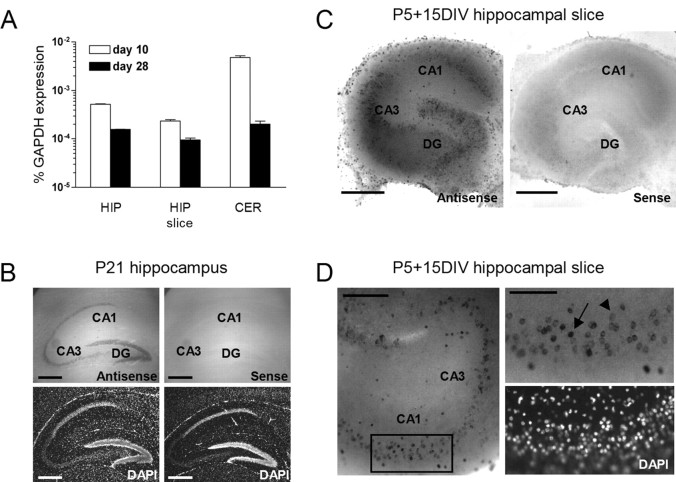Figure 1.
Expression pattern of the p75NTR in the mouse hippocampus. A, Quantitative real-time PCR assays document the expression of p75NTR in the developing hippocampus (HIP) and cerebellum (CER) as well as in hippocampal slice cultures (HIP slice). CNS tissues were obtained from animals 10 or 28 d of age. The slices had a corresponding age and were isolated from a P5 mouse brain allowed to mature in vitro for an additional 5 or 23 d, respectively. Note that, in each case, p75NTR expression is developmentally downregulated. Gene expression data are shown as percentage relative p75NTR transcript levels normalized to GAPDH mRNA. The error bars indicate the SD of the mean of three measurements. A total of four independent real-time PCR experiments were performed (3 using probe set p75NTR-A and 1 with probe set p75NTR-B), all giving similar results. B, Micrographs showing in situ hybridization for p75NTR mRNA in the P21 mouse hippocampus. Note p75NTR gene expression in the dentate gyrus and in both the CA1 and CA3 region [4′,6′-diamidino-2-phenylindole dihydrochloride (DAPI) staining in the bottom panels]. Sections incubated with the p75NTR sense probe did not show specific staining (right panels). Scale bar, 1 mm. C, Micrographs showing the in situ hybridization for p75NTR mRNA in hippocampal slice cultures derived from P5 mouse and cultivated for 15 d. Similar to the in vivo condition, p75NTR mRNA was detected in the dentate gyrus as well as in CA1 and CA3. Sections incubated with the sense probe did not reveal specific staining (right panel). Scale bar, 1 mm. D, Left, Higher magnification of the CA1 area of a culture stained with the p75NTR antisense probe showing a significant number of positive cells in all of the areas mentioned above. Right, A higher magnification shows several positive cells in the CA1 region. Scale bar, 500 and 100 μm, respectively. In situ hybridizations shown in B-D were performed on more than five occasions each with identical outcome.

